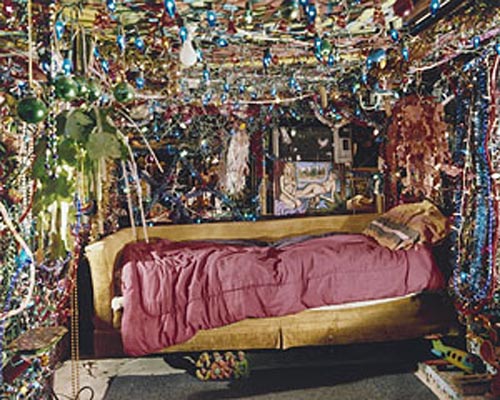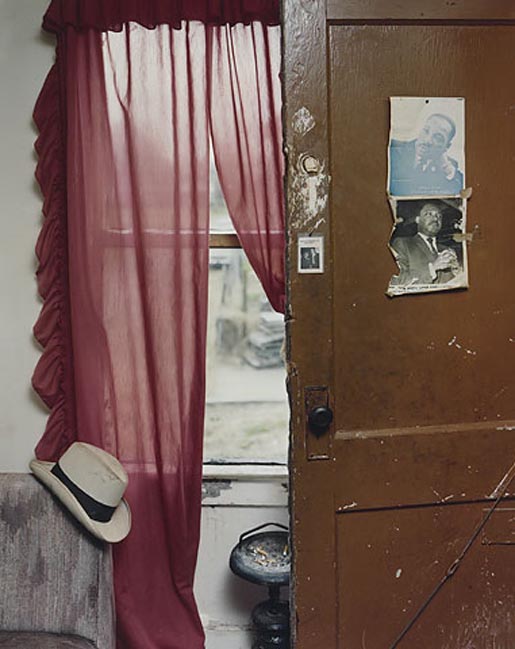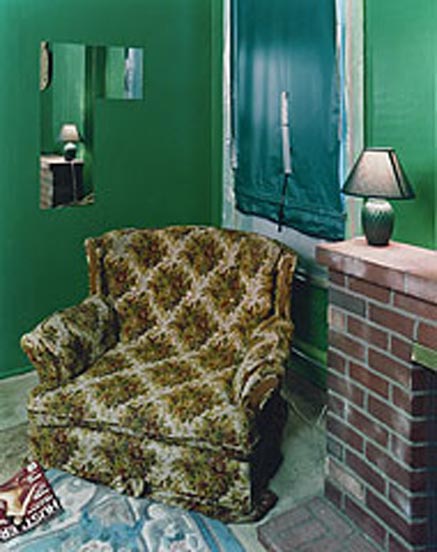Alec Soth, Sleeping by the Mississippi, Is Now Wide Awake in Minneapolis
Michael Fallon revisits Alec Soth after his appearance in the Whitney Biennial to find out what happens to an artist when sudden fame arrives.



This is the last piece for a while in our Whitney coverage; we’ll be running a piece this summer by Walker curator Douglas Fogle on his take on the show, along with a collection by several local curators of artists whose careers go beyond Minnesota.
Here’s a question that most people never get a chance to answer: What happens when your greatest dreams suddenly come true? What changes occur, for instance, in the mind of the quiet girl who is discovered by a Hollywood talent agent? What dilemmas face the athlete brought up to the Bigs days after his high school graduation? Is there any kind of reality check available to the political candidate who wins a big election the first time out?
When I visit the suddenly famous photographer Alec Soth in his Northeast Minneapolis studio on a recent Saturday afternoon, the atmosphere is markedly different from when I saw him there this past summer. For one, Soth, who is thirty-four, has lost a bit of the softness I saw in him back then. While he still has a lumberjacky beard and a Beatlesque mop of soft black hair, now his tall frame is gaunter, his shoulders more weighed down.
“It’s been crazy,” Soth says of his life and work now. “It’s been good crazy . . . Things have really changed.”
What’s changed since this past summer is Soth has become star in the art world—not just in the Minnesota art world, such as it is, but the international art world—ever since he was included as a participant in the 2004 Whitney Biennial. These days, queries come in from all over the world for him to provide images to such-and-such a publication, or to be involved in a show or art fair in such-and-such international city. Among other things, Soth has received assignments from the New York Times Magazine and from Newsweek. His work was featured in a Time magazine article on the Biennial, in the front section of the New Yorker, on the cover of Blindspot, and in advertisements for the Biennial itself.
Soth just had his first New York solo show at the Yossi Milo gallery in Chelsea, which was well-received critically.He says he gets two emails a day from people wanting to assist him in his studio. “It’s wonderful,” he says. “There are a lot of good young photographers out there. I get so many offers for things now, and I have to think through them.”
Just a glance at his studio confirms what Soth is saying. The place is overrun, cramped, with shelves holding photographic paper, walls with event notices stuck to them, and tables full of proof sheets. Justin, one of the two assistants he’s now paying to do his work, interrupts us regularly as we talk—simply because there’s so much to do now, and so little time. They confer about the shadows in a particular photo that’s slated to appear in an upcoming show—maybe they need more dodge here, more burn there, and perhaps a little extra yellow. Here’s a typical exchange:
Justin: This is a tough one.
Alec: The yellow is out I think.
Justin: You got red.
Alec: Yes, this is a tough one.
(Pause.)
Alec: How crazy would it be to do a “swooping-in” burn? Would that be a bad idea?
(Justin exits to try said crazy idea.)
“Everything is completely upside down from where I was,” Soth says, once Justin has left. Soth speaks of getting a request from a “dog literary magazine” that wanted to use one of his images. “OK, that was one of the few times that I was able to say ‘I don’t have time,'” says Soth. “I don’t even have time to make prints. I’m at the computer, emailing, all the time. That’s the new life. But I’m making a living as an artist, and it is paying for new work. So this is exciting. “
He speaks of how often he’s on the road now—in fact, he’s just come back from an exhibition that opened in Ontario, Canada, and he has exhibitions coming up in the next few months in San Francisco, Minneapolis, and Berlin. “It just keeps going. The hard part is I don’t see an end to it. There are any number of exhibitions for any number of months. There’s no end to the kind of production that’s going on.”
TRAVEL IS NOTHING NEW FOR SOTH. His photographic eye has long traveled –most notably for a series of photos taken on trips down the Mississippi River. The resulting body of work, “Sleeping by the Mississippi,” asks roughly this question: What is Middle America? These are the images that have made him famous—included in the Biennial and publications around the world. The people and places Soth finds to depict in his photos are universally American. They are people who visit polka bars with red vinyl booths, people with paint peeling in their bedrooms, people with burgundy Barcaloungers who secretly read Hustler by the fireplace. His roving eye is drawn to particular types–traveling preachers, hookers and convicts, aging Southern matrons, barflies, and endless salt-of-the-earth types that inhabit the heartland.
It’s not often mentioned that Soth works serially. That is, his projects are long and involve larger topics that take many shoots and build up meaning through time. Because of this serial aspect, individual images can’t represent the depth of what he does. While some of Soth’s images are very compelling, they don’t show the network of ideas, conceits, and poetic imagery in the entire body of a project. For instance, a photo of a bed is just that, an individual bed. When taken in the context of the other beds Soth has found on his journey down the Mississippi, though, the one bed is part of a portrait of the national psyche. Some beds in this series are abandoned (in a Louisiana swamp), and some are preserved as museum pieces (at Lindberg’s boyhood home). Some beds are full of other sorts of meaning (in a Memphis motel, bearing a prostitute), and some are points of refuge (in the home of a tired old Southern matron). Meaning grows in Soth’s work by this accretion of imagery, like in an epic poem or a good novel. Likely the best possible way to see a series by Soth is in a book, and in fact the German publisher Steidl is releasing a book of the images from “Sleeping by the Mississippi” this fall.
The difference between what the body of this work represents and what an individual photograph represents is so marked that seeing individual images from a Soth series can lead to misunderstanding of what his work is about. For instance, a colleague reported overhearing someone at the Biennial saying, “Here’s Alec Soth. He really loves photographing white trash.” Soth himself cited, with a pained look, one weblog that criticized his work as “hicksploitation.” And, viewed one at a time, the ramshackle shacks, the downtrodden people, the crush of middle-American trappings that appear in a particular photo might convey that meaning. But when the series is seen entire and connections are made between its parts, Soth’s work is more akin to a Steinbeck novel or a book by James Agee, in which the heroism of people living and facing their lives, their troubled dignity, and the poetry of their connection to other humans in similar circumstances, all shine through.
Despite the drawbacks of the serial form, Soth can’t seem to help himself, and he has already begun work on his next series of photos–on a subject he says is a companion to the Mississippi project. He’s traveled twice now to the Niagara area to explore the life around that body of water. “Mississippi was about the wandering spirit,” says Soth. “This is more about love and relationships—the honeymoon.” Some of the initial photos in the series reveal the themes he is already developing. Pictures show couples, motels, local jewelry shops, a woman’s scrapbook dedicated to the love of her life–a member of the rock band Kiss. There are some definite hits among the photos he’s taken so far, but there is much more work to be done–a fact that Soth readily acknowledges. He doesn’t set out to make his task easy.
And in fact, Soth’s process of photographing is complicated, and reliant both on fortuity and on a nearly endless amount of patience. This may simply be dictated by his use of a large-format camera, a device that must be reconstructed anew for each shoot from a variety of parts, and that uses large and expensive negatives. Soth says he’s lucky if he manages to make one or two exposures on a given day of shooting. But overall, he’s happy to have had the chance to take more photos.
“I’ve been so sick of the old photos, and talking and looking at them,” says Soth. “I feel like a fraud. It’s been years since I took those pictures, so it’s been great to do this [new series]. There are some good images. I’m starting to see how it’s all connected.”
In the end, Soth knows how good his life is now. He has plans at present to buy a studio building closer to his home. This would likely give him more space to spread out his growing business, and it would keep him closer to home and his young daughter (whom he and his wife adopted just a few months before he found out he was accepted to the Biennial). “I know I got lucky,” says Soth. “Just the fact that anyone knows who I am now is fascinating to me. That anyone in the photography world in New York has heard of me is a new concept…. It’s a great feeling. But I wonder if it’s going to last.”